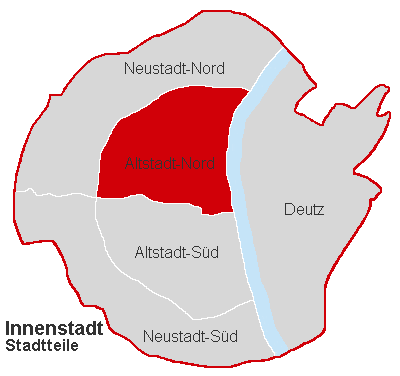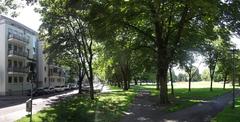
Altstadt-Nord Cologne Visiting Hours, Tickets, and Historical Sites Guide
Date: 14/06/2025
Introduction to Altstadt-Nord Cologne: History and Modern Life
Altstadt-Nord, the northern sector of Cologne’s Old Town, is where centuries of history meet a vibrant present. Founded as Colonia Claudia Ara Agrippinensium by the Romans in 50 CE, this district is steeped in archaeological and architectural marvels. Remnants of Roman walls, the Praetorium, and treasures in the Roman-Germanic Museum reflect the city’s ancient prominence. The awe-inspiring Cologne Cathedral (Kölner Dom), now a UNESCO World Heritage Site, dominates the skyline and exemplifies Cologne’s enduring religious and cultural significance.
Despite widespread devastation in World War II, Altstadt-Nord was painstakingly rebuilt, preserving its unique blend of Roman, medieval, and modern influences. Today, it’s a lively urban center where traditions such as the Cologne Carnival and Kölsch beer culture thrive alongside world-class museums, galleries, and bustling shopping streets. Excellent public transport, guided tours, and visitor amenities make it accessible for all.
This guide covers Altstadt-Nord’s historical highlights, practical visitor information—including opening hours, ticketing, and accessibility—plus travel tips and nearby attractions. For the latest updates, consult the official Cologne Cathedral website and Cologne Tourism.
Table of Contents
- Roman Foundations and Early Development
- Medieval Growth and Ecclesiastical Power
- Destruction and Postwar Reconstruction
- Living Traditions and Cultural Significance
- Key Architectural Landmarks
- Visitor Information: Hours, Tickets, Accessibility
- Travel Tips and Nearby Attractions
- Visuals and Media
- Frequently Asked Questions (FAQ)
- Preservation and Contemporary Relevance
- References
Roman Foundations and Early Development
Altstadt-Nord’s roots stretch back more than 2,000 years. As Colonia Claudia Ara Agrippinensium, the city became a vital military, administrative, and commercial hub in Roman Germania. Strategic placement along the Rhine fostered trade and growth, while remnants of Roman streets, fortifications, and the Praetorium (the governor’s palace) still anchor the district (germanytravel.blog).
Key archaeological sites include the Roman-Germanic Museum, home to mosaics, statues, and artifacts like the Dionysus mosaic, discovered in situ. These remains offer a vivid window into Cologne’s ancient prosperity.
Medieval Growth and Ecclesiastical Power
After Roman rule, Cologne evolved into a major center in the Frankish and Holy Roman Empires. The district’s medieval legacy is embodied in the Cologne Cathedral, begun in 1248 and completed over six centuries later. Its 157-meter twin spires remain a city symbol (Cologne Cathedral Official Site).
Other medieval highlights include Romanesque churches such as Groß St. Martin, St. Andreas, and St. Gereon. The area’s narrow alleys, bustling squares like Alter Markt and Heumarkt, and the 14th-century City Hall (one of Germany’s oldest) reflect a rich civic and religious life (germanytravel.blog).
Destruction and Reconstruction in the Modern Era
World War II air raids devastated Altstadt-Nord, destroying around 90% of the Old Town. Postwar rebuilding balanced respect for historic character with modern needs. Surviving churches, the City Hall, and select Romanesque structures guided the restoration. Today, restored cobblestone streets, pastel facades, and vibrant squares evoke both the district’s heritage and its resilience (germanytravel.blog).
Living Traditions and Cultural Significance
Altstadt-Nord remains a living district, where tradition thrives. The Cologne Carnival fills its streets with music, costumes, and parades each year. Historic taverns serve Kölsch beer and local specialties like Himmel un Ääd and Halver Hahn—culinary traditions that have endured for centuries (germanytravel.blog).
Key Architectural Landmarks
- Cologne Cathedral: Gothic masterpiece, UNESCO site, home to the Shrine of the Three Kings (Cologne Cathedral Official Site).
- Great St. Martin Church: Striking Romanesque church with a distinctive tower.
- Old Town Hall: Features a Renaissance loggia and a statue-adorned tower.
- Hohenzollern Bridge: Noted for its “love locks” and panoramic views.
- Museum Ludwig: Major collection of modern art (museum-ludwig.de).
- Roman-Germanic Museum: Roman-era artifacts and mosaics.
- Wallraf-Richartz Museum: European art from the Middle Ages through Impressionism.
- Fragrance Museum (Farina Haus): Traces the origins of Eau de Cologne.
The district’s walkable layout, with intimate squares and shopping streets, blends the past with modern vibrancy.
Visitor Information: Hours, Tickets, Accessibility
Cologne Cathedral
- Hours: Daily, 6:00 AM–7:30 PM (may vary seasonally).
- Tickets: Main nave free; tower and treasury approx. €5–€6. Official website.
- Accessibility: Wheelchair accessible (except tower climb).
Great St. Martin Church
- Hours: Daily, 9:00 AM–6:00 PM. Free entry.
Old Town Hall
- Hours: Monday–Friday, 10:00 AM–4:00 PM. Tours by appointment; ticket required.
Museum Ludwig
- Hours: Tuesday–Sunday, 10:00 AM–6:00 PM (Thursdays until 9:00 PM). Closed Mondays. Tickets €12.
Roman-Germanic Museum
- Hours: Temporary exhibition sites; check official website.
Wallraf-Richartz Museum
- Hours: Tuesday–Sunday, 10:00 AM–6:00 PM. Tickets €10.
Fragrance Museum
- Hours: Monday–Saturday, 10:00 AM–6:00 PM. Tickets €6 (farina1906.com).
Note: Most sites are wheelchair accessible, though some historic buildings have limited access. Comfortable walking shoes recommended due to cobblestone streets.
Getting There: Altstadt-Nord is adjacent to Köln Hauptbahnhof (Cologne Central Station) and served by multiple tram and bus lines. Limited parking; public transport is advised.
Travel Tips and Nearby Attractions
- Best Times to Visit: Spring and early autumn for mild weather and fewer crowds.
- Guided Tours: Available for various themes—history, architecture, culinary. Book through official tourism channels or download audio guides via the Audiala app.
- Nearby: NS Documentation Center (EL-DE Haus), Rhine promenade, Chocolate Museum, shopping streets (Schildergasse, Hohe Straße).
- Where to Stay: Wide range of hotels and hostels within walking distance (travelhotelexpert.com).
Visuals and Media
High-quality images of the Cologne Cathedral, Altstadt-Nord’s streets, and local festivals are recommended. Use descriptive alt texts such as “Cologne Cathedral visiting hours” and “Altstadt-Nord historical sites” for better accessibility and SEO.
Interactive maps and virtual tours are available through official tourism sites, enhancing trip planning.
Frequently Asked Questions (FAQ)
Q: What are the Cologne Cathedral’s visiting hours?
A: Generally, 6:00 AM–7:30 PM, but check the official website for seasonal changes.
Q: Is entry to the cathedral free?
A: Yes, entry to the nave is free; tickets are required for tower and treasury access.
Q: Are guided tours available?
A: Yes, both guided and audio tours are offered for the cathedral and other major sites.
Q: Is Altstadt-Nord accessible for people with disabilities?
A: Most attractions and public transport are accessible, though cobblestones and some older buildings may pose challenges.
Q: When is the best time to visit?
A: Spring and early autumn for pleasant weather and fewer crowds; Carnival and Christmas markets for unique cultural experiences.
Q: What are the top museums in Altstadt-Nord?
A: Museum Ludwig, Wallraf-Richartz Museum, Roman-Germanic Museum.
Preservation and Contemporary Relevance
Altstadt-Nord’s unique identity is safeguarded by strict local regulations and ongoing restoration efforts. Adaptive reuse of historic buildings and a vibrant cultural scene ensure its continued relevance. Museums and institutions foster appreciation for the district’s layered history (Cologne Tourism Official Site).
References
- Cologne Cathedral Official Site
- Cologne Tourism Official Site
- Germany Travel Blog: Old Town Guide
- Koeln.de: Altstadt-Nord Overview
- Museum Ludwig
- The Crazy Tourist: Best Things in Cologne
- Travel Hotel Expert: Where to Stay in Cologne
- Farina Fragrance Museum
Altstadt-Nord offers an immersive journey through Cologne’s history and living culture. Plan your visit with this guide, consult official resources for current details, and consider the Audiala app for expert audio tours. Whether you’re exploring the majestic cathedral, savoring Kölsch beer, or wandering medieval streets, Altstadt-Nord captures the enduring spirit of Cologne.







































































